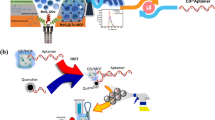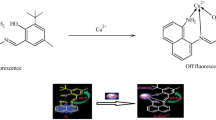Abstract
Here we report the monitoring the instant creation of a new fluorescent signal (FS) aroused from a positively charged water-soluble fluorogenic probe, ethidium bromide (EtBr) in the presence of a radical initiator, ammonium persulfate (APS) and an accelerator, tetraethylmetilendiamine (TEMED) for evaluation of deoxyribonucleic acid (DNA) conformation. The results revealed that the occurred FS (λex = 430 nm; λmax = 525 nm) is a reduced form of EtBr (λex = 480 nm; λmax = 617 nm) and it is completely distinct from hydroethidine (λex = 350 nm; λmax = 430 nm), which is two-electron reduced form of EtBr. It was noticed that EtBr was reduced to a new FS during the polymerization of N, N dimethyacrylamide (DMAA) too, at 25 °C in the presence of APS and TEMED or at 55 °C with only APS, and the rate of formation of FS was increased upon treatment time. The effect of nanoclays such as Laponite XLG® and Laponite XLS®, which provide a protective environment for DNA in nature, were also investigated through the reduction process of EtBr in the absence and presence of a water soluble monomer DMAA. We demonstrated that DNA conformation might be evaluated by monitoring FS effectuated during the reduction of EtBr in the presence of nanoclays having positively and negatively charged surfaces. Protective property of DNA against the formation of reduced product was elucidated by carrying out the polymerization at 55 °C. The results revealed that the monitoring of formation of FS in the presence of radical initiator could lead to elucidate the conformation of DNA upon formation of intercalator complex.











Similar content being viewed by others
References
Lavis LD, Raines RT (2008) Bright ideas for chemical biology. ACS Chem Biol 3:142–155
Terai T, Nagano T (2008) Fluorescent probes for bioimaging applications. Curr Opin Chem Biol 12:515–521
Wysocki LM, Lavis LD (2011) Advances in the chemistry of small molecule fluorescent probes. Curr Opin Chem Biol 15:752–759
Chib R, Raut S, Sabnis S, Singhal P, Gryczynski Z, Gryczynski I (2014) Associated anisotropy decays of ethidium bromide interacting with DNA. Methods Appl Fluoresc 2
Mukherjee A, Singh B (2017) Binding interaction of phatinaceutical drug captopril with calf thymus DNA: a multispectroscopic and molecular docking study. J Lumin 190:319–327
Liu BM, Bai CL, Zhang J, Liu Y, Dong BY, Zhang YT, Liu B (2015) In vitro study on the interaction of 4,4-dimethylcurcumin with calf thymus DNA. J Lumin 166:48–53
Roy S, Saxena SK, Mishra S, Yogi P, Sagdeo PR, Kumar R (2018) Spectroscopic evidence of phosphorous heterocycle-DNA interaction and its verification by docking approach. J Fluoresc 28:373–380
Cosa G, Focsaneanu KS, McLean JRN, McNamee JP, Scaiano JC (2001) Photophysical properties of fluorescent DNA-dyes bound to single- and double-stranded DNA in aqueous buffered solution. Photochem Photobiol 73:585–599
Sun YT, Peng TT, Zhao L, Jiang DY, Cui YC (2014) Studies of interaction between two alkaloids and double helix DNA. J Lumin 156:108–115
Paramanik B, Bhattacharyya S, Patra A (2013) Steady state and time resolved spectroscopic study of QD-DNA interaction. J Lumin 134:401–407
Yuvaraj M, Aruna P, Koteeswaran D, Tamilkumar P, Ganesan S (2015) Rapid fluorescence spectroscopic characterization of salivary DNA of normal subjects and OSCC patients using ethidium bromide. J Fluoresc 25:79–85
Geng SQ, Wu Q, Shi L, Cui FL (2013) Spectroscopic study one thiosemicarbazone derivative with ctDNA using ethidium bromide as a fluorescence probe. Int J Biol Macromol 60:288–294
Zhou XY, Zhang GW, Wang LH (2014) Binding of 8-methoxypsoralen to DNA in vitro: monitoring by spectroscopic and chemometrics approaches. J Lumin 154:116–123
Agarwal S, Jangir DK, Mehrotra R (2013) Spectroscopic studies of the effects of anticancer drug mitoxantrone interaction with calf-thymus DNA. J Photochem Photobiol B Biol 120:177–182
Rafique B, Khalid AM, Akhtar K, Jabbar A (2013) Interaction of anticancer drug methotrexate with DNA analyzed by electrochemical and spectroscopic methods. Biosens Bioelectron 44:21–26
Temerk Y, Ibrahim M, Ibrahim H, Kotb M (2015) Interactions of an anticancer drug Formestane with single and double stranded DNA at physiological conditions. J Photochem Photobiol B Biol 149:27–36
Xia KX, Zhang GW, Li S, Gong DM (2017) Groove binding of vanillin and ethyl vanillin to calf Thymus DNA. J Fluoresc 27:1815–1828
Benov L, Sztejnberg L, Fridovich I (1998) Critical evaluation of the use of hydroethidine as a measure of superoxide anion radical. Free Radic Biol Med 25:826–831
Budd SL, Castilho RF, Nicholls DG (1997) Mitochondrial membrane potential and hydroethidine-monitored superoxide generation in cultured cerebellar granule cells. FEBS Lett 415:21–24
Zhao H, Kalivendi S, Zhang H, Joseph J, Nithipatikom K, Vásquez-Vivar J, Kalyanaraman B (2003) Superoxide reacts with hydroethidine but forms a fluorescent product that is distinctly different from ethidium: potential implications in intracellular fluorescence detection of superoxide. Free Radic Biol Med 34:1359–1368
Zielonka J, Kalyanaraman B (2010) Hydroethidine- and MitoSOX-derived red fluorescence is not a reliable indicator of intracellular superoxide formation: another inconvenient truth. Free Radic Biol Med 48:983–1001
Kalyanaraman B, Dranka BP, Hardy M, Michalski R, Zielonka J (2014) HPLC-based monitoring of products formed from hydroethidine-based fluorogenic probes - the ultimate approach for intra- and extracellular superoxide detection. Biochim Biophys Acta-General Subjects 1840:739–744
Maghzal GJ, Cergol KM, Shengule SR, Suarna C, Newington D, Kettle AJ, Payne RJ, Stocker R (2014) Assessment of myeloperoxidase activity by the conversion of hydroethidine to 2-chloroethidium. J Biol Chem 289:5580–5595
Michalski R, Michalowski B, Sikora A, Zielonka J, Kalyanaraman B (2014) On the use of fluorescence lifetime imaging and dihydroethidium to detect superoxide in intact animals and ex vivo tissues: a reassessment. Free Radic Biol Med 67:278–284
Thomas G, Roques B (1972) Proton magnetic-resonance studies of ethidium bromide and its sodium-borohydride reduced derivative. Febs Lett 26:169–175
Phukan S, Mitra S (2012) Fluorescence behavior of ethidium bromide in homogeneous solvents and in presence of bile acid hosts. J Photochem Photobiol A Chem 244:9–17
Acknowledgements
This work was supported by Istanbul Technical University (ITU), BAP 39773. O.O. thanks to Turkish Academy of Sciences (TUBA) for the partial support.
Author information
Authors and Affiliations
Corresponding authors
Electronic supplementary material
ESM 1
(DOCX 850 kb)
Rights and permissions
About this article
Cite this article
Uzumcu, A.T., Guney, O. & Okay, O. Monitoring the Instant Creation of a New Fluorescent Signal for Evaluation of DNA Conformation Based on Intercalation Complex. J Fluoresc 28, 1325–1332 (2018). https://doi.org/10.1007/s10895-018-2294-4
Received:
Accepted:
Published:
Issue Date:
DOI: https://doi.org/10.1007/s10895-018-2294-4




